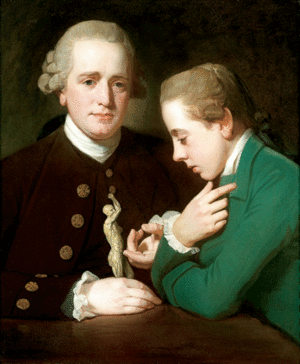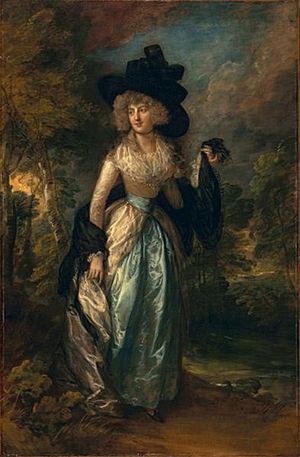Robert Petre, 9th Baron Petre facts for kids
Quick facts for kids
The Lord Petre
|
|
|---|---|

Lord Petre showing an écorché figure to his son, Robert, by George Romney, c. 1775, Collection of McMaster Museum of Art, McMaster University
|
|
| Grand Master of the Premier Grand Lodge of England | |
| In office 1772–1777 |
|
| Preceded by | The Duke of Beaufort |
| Succeeded by | The Duke of Manchester |
| Personal details | |
| Born |
Robert Edward Petre
March 1742 Ingatestone Hall |
| Died | 2 July 1801 (aged 59) |
| Spouses |
Anne Howard
(m. 1762; died 1787)Juliana Barbara Howard
(m. 1788) |
| Relations | James Radclyffe, 3rd Earl of Derwentwater (grandfather) |
| Children | 7 |
| Parents | Robert Petre, 8th Baron Petre Lady Henrietta Anna Mary Barbara Radclyffe |
Robert Edward Petre, 9th Baron Petre (born March 1742 – died July 1801) was an important British noble. He was a leading member of the English Roman Catholic community. Robert came from a very rich family and used his wealth to help others. He was also key in building the new Thorndon Hall and a house in London.
Contents
Early Life and Family History
Robert Edward Petre was born at Ingatestone Hall in March 1742. His father, Robert James Petre, 8th Baron Petre, died from smallpox when Robert was only five months old. His mother, Lady Henrietta Anna Mary Barbara Radclyffe, looked after him until she passed away in 1760.
Robert's family was incredibly wealthy. His ancestor, Sir William Petre, had bought about 45,000 acres (182 km²) of land. His son, John, added another 14,500 acres (59 km²). Robert's grandmother, Catherine Walmesley, also inherited large estates.
Although we don't have many of Robert's personal writings, he was known for being very energetic and determined. He was also a patriotic person who cared deeply about his country.
Family Challenges and Resilience
Robert's family faced many sad events. His mother lost her husband, father, and uncle early in life. His grandmother, Catherine Walmsley, also experienced much loss. She became a widow at just 15 years old. These experiences likely taught Robert to be strong when facing difficulties.
When Robert's father died, Robert became the 9th Lord Petre. He was still a child, so his mother managed his estates. When she died in 1760, Robert took control of his family's wealth at age eighteen.
Helping His Community
Robert was very generous. He gave £500 each year to charities, especially to Roman Catholic priests and religious groups. He also helped build the Chelmer and Blackwater Navigation, a canal connecting Chelmsford to the sea.
During a war with France, Robert showed his patriotism. He gathered a group of volunteers from nearby towns. Their banners were still in Ingatestone Church many years later.
Fighting for Catholic Rights
Robert was a major leader in the movement for Catholic Emancipation. This was a time when Roman Catholics in England faced many unfair laws. These laws, called Penal Laws, stopped Catholics from practicing their religion freely. They also couldn't hold public jobs or professions. This made them feel like "second-class citizens."
Why Laws Targeted Catholics
The laws against Catholics weren't just about religion. People worried about how much power the Pope had over Catholics. They feared that if the Pope told Catholics to go against the King, they would obey. This was a big concern for the government.
Even though the laws were strict, some Catholic families, like the Petres, were not always bothered too much. They couldn't hold public office, but this meant they could focus on managing their lands. This often made their estates even more successful. Also, many local communities supported their Catholic neighbors, which helped protect them.
Robert's Bold Actions
Robert wanted to restore rights and freedoms for Catholics. To do this, he needed to convince people that Catholics were loyal to the King, not just the Pope.
In 1771, Robert made a bold move: he became a Freemason. At the time, the Pope had forbidden Catholics from joining Freemasonry. Robert's action showed that he didn't believe the Pope had power over his loyalty to the King. This move also helped him meet important Protestant leaders. Just one year later, in 1772, he was elected Grand Master of the Premier Grand Lodge of England. He held this position until 1777.
Leading the Fight for Change
Robert led two committees of Catholic laymen. These groups worked to convince the government to remove the Penal Laws. Robert was the perfect person to lead because other high-ranking Catholic nobles preferred a quiet life.
The committees faced challenges, even from some Catholic clergy. Some clergy feared that pushing for more rights would lead to more violence against Catholics. Others believed the Pope's authority was absolute, even in state matters. Despite these disagreements, Robert's committee made progress.
The government, especially the Whig party, supported Catholic Emancipation. Even the Tory government was sympathetic. They saw it as a way to stop people from leaving Ireland and encourage Scottish Highlanders to join the army. The public and the press also largely supported the cause.
A Royal Visit and Setbacks
In 1778, King George III visited Robert at Thorndon Hall. This was a huge deal because it was the first time a British monarch had visited a Catholic home since the Reformation. It showed that the government was starting to accept Catholics.
However, not everyone was happy. The First Relief Act of 1778 removed some restrictions on Catholics. But it led to the Gordon Riots, a huge public disturbance. Rioters even burned down Robert's new house in London. This made the government nervous about giving more rights to Catholics.
The Second Relief Act in 1791 allowed Catholic chapels and schools. But Catholics still couldn't be in Parliament or hold high military positions. Robert raised a militia of 250 volunteers for the French Wars. He wanted his son to lead them, but the King refused because his son was Catholic.
Robert died before seeing full Catholic Emancipation. But his work paved the way. The Emancipation Act of 1829 removed most restrictions. Today, only Catholics are barred from becoming the monarch.
Building and Renovating Grand Homes
Another big project for Robert Petre was building the new Thorndon Hall. His father had started to rebuild the old 15th-century house, but he died before finishing. The house and park became neglected. In 1757, a fire badly damaged the old house.
When Robert took over, the house was in poor condition. He hired James Paine, a famous architect, to design a completely new house. He also hired Lancelot 'Capability' Brown to redesign the park. Robert tore down the old Thorndon Hall and built the grand Palladian mansion you see today.
Designing Thorndon Hall
Work on the new Thorndon Hall began in 1764. The family lived temporarily at Ingatestone Hall. The new mansion was huge. It had a central block with a large hall, grand staircase, and many rooms. These included bedrooms, a study, drawing-rooms, a dining-room, a ballroom, and even a theatre. Two wings connected to the main block. The East wing had kitchens and a chapel. The West wing held coach-houses and stables.
Building Thorndon Hall took six years and cost an estimated £250,000 (about £22 million today). As it neared completion, Robert also asked James Paine to design a new house in Park Lane, London. This house was later burned down during the Gordon Riots.
Running such large homes was very expensive. In 1760, Robert employed 35 servants at Thorndon Hall. Even with modest salaries, the yearly wage bill was £473 18s.
Personal Life and Family

Robert was enthusiastic about his family life. He married his first wife, Anne Howard, on April 19, 1762. She was the daughter of Philip Howard. Robert and Anne had four children:
- Robert Edward Petre, 10th Baron Petre (1763–1809)
- George William Petre (1766–1797)
- Anne Catherine Petre (c. 1768–1798)
- Philip Howard (born 1773)
Robert and Anne generally stayed out of politics. But during the American Revolution, they went to Court for the first time. This was to show their loyalty to the King. King George III and Queen Charlotte even visited them at Thorndon Hall in 1779.
Anne died in 1787. A year later, on January 16, 1788, Robert married Juliana Barbara Howard in London. Juliana was 19 years old, 27 years younger than Robert. His son had married her older sister two years before. Juliana and Robert had three children:
- Julia Maria Petre (c. 1790–1844)
- Catherine Anne Petre (c. 1792–1830)
- Edward Robert Petre (1794–1848)
Death and Legacy
Robert Edward Petre died on July 2, 1801. His funeral was a grand event. Volunteers, soldiers, and many mourners joined the procession. Field pieces (small cannons) fired as his body was taken to the church. It was a huge gathering, showing how much people respected him.
Robert's death marked the end of a golden age for the Petre family. They never again reached such a high level of wealth and influence. His death also signaled a change in society. The Industrial Revolution and a growing middle class meant that the old system, where rich landowners protected their communities, was fading. For Catholics, as they gained more rights, they relied less on the protection of wealthy families like the Petres.
Images for kids



